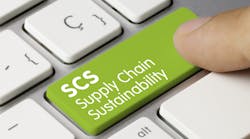Download this article in PDF format.
The news headlines are filled with the advances large corporations are making on the environmental sustainability front: Starbucks is storing more carbon than it emits, fully eliminating waste, and replenishing more water than it uses; Unilever sourced 62% of its raw materials from sustainable sources in 2019, and is now using artificial intelligence (AI) and blockchain technologies to get to the point where all materials come from 100% sustainable sources; and Walmart’s Project Gigaton is working to avoid the emissions of 1 billion metric tons of greenhouse gas throughout its value chain.
These are just a few examples of large-enterprise initiatives, but small-to-mid-sized businesses (SMBs) are also throwing their hats into the sustainability ring. Defined by Gartner as companies that have 100 or fewer employees (for a small business) or between 100-999 employees (for a mid-sized firm), SMBs typically have either less than $50 million in annual revenues (for small companies) or somewhere between $50 million and $1 billion in revenues (for a mid-sized organization).
A Force to be Reckoned with
The actions that SMBs take to run greener supply chains is significant for one very big reason: In 2020, their numbers reached 31.7 million in the U.S. alone, which means SMBs made up nearly all (99.9%) of businesses nationwide. So while their larger counterparts may capture the headlines each time they announce a new supply chain sustainability initiative, the work that SMBs are doing in this regard is also extremely important and noteworthy.
And while some of these efforts are being driven from the top-down, others are being developed in response to consumer demands for more sustainable supply chain practices.
“Millennials are becoming the top consumer group and largest presence in the U.S. workforce, and they have a focus previous generations didn’t give much thought to: They demand that companies take action on sustainability,” Software Advice’s Olivia Montgomery writes. “From sustainable sourcing of products to being socially responsible, younger generations want to support businesses invested in green practices across their supply chains.”
Software Advice defines sustainability as something that encourages businesses to frame decisions in terms of human and environmental impact for long-term rather than short-term gains. Examples of sustainable actions include reducing the use of plastic and carbon dioxide, sourcing raw materials from sustainable partners, and supporting ethical work and pay practices.
Surveying the SMB Landscape
To learn more about the current trends, concerns and business impacts of SMB sustainability measures over the last 18 months, Software Advice surveyed more than 500 supply chain professionals working at companies with 500 or fewer employees. It wanted to find out what those companies are doing to operate more sustainably and also offers advice for doing so in its recent report, How SMBs Are Creating More Sustainable Supply Chains in 2021.
Here’s what it learned:
- Sourcing from sustainable manufacturers (54%) and working with eco-friendly partners (53%) are the top actions taken by SMBs.
- ·Before the pandemic, 86% of respondents had some type of supply chain sustainability effort in place at their business, with environmental sustainability being the most common type.
- 99% of SMBs plan to keep or increase their environmental sustainability efforts even after the pandemic ends.
- 83% of SMBs use software to support their sustainability efforts, and 60% say software usage saves them time. Supply chain management and project management solutions are reportedly the most used tools.
- 58% of SMBs report high costs, both direct (e.g., buying more expensive materials) and indirect (e.g., longer process/workflow times), as the biggest downside to investing in supply chain sustainability.
- Of the SMBs that are investing in sustainability efforts…
- 85% are investing in environmental efforts (reducing waste, preventing pollution, etc.)
- 60% are investing in social efforts (health and social equity, labor rights)
- 49% are investing in economic efforts (sustainable practices, sustainability KPIs and metrics)
- Over half of the respondents (54%) report increasing their efforts in environmental sustainability in the past 18 months. And all, but one respondent, have plans to keep or increase their environmental sustainability efforts after the pandemic.
Challenges and Rewards
In pinpointing the roadblocks to supply chain sustainability for SMBs, the survey says that cost remains the top challenge for companies working toward sustainable supply chains. In fact, 58% of respondents cited high costs, both direct (e.g., buying more expensive materials) and indirect (e.g., longer process/workflow time), as the biggest downside to investing in supply chain sustainability.
The good news is that once the initial investment is completed, “cost savings is the most common benefit of sustainability investment,” the company adds, “as reported by 46% of our survey respondents.”









